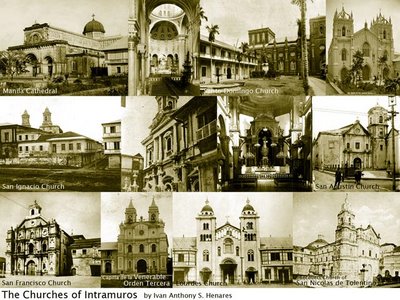 We have been trying influence many of the local government leaders and the clergy to adopt heritage conservation practices to preserve the character of our own cities and towns. But add to the fact that so much was already lost during the Second World War which is why we have to be more aggressive in protecting what's left.To illustrate my point, I will hark back at the good old pistaym days when Manila was in its heyday. In Intramuros today, there are only two churches left, namely the Manila Cathedral and San Agustin Church. In fact, the Manila Cathedral that is standing today is a reconstruction of the original one and only San Agustin was unscathed during the war.Before the war, there were at least nine of these grandiose and gargantuan churches within meters away from each other. These included the Manila Cathedral, Santo Domingo Church with the original main building of the University of Santo Tomas beside it, the Jesuit Church of San Ignacio beside the Ateneo de Manila (it was said that "there was so much wood in the church that it took all of four days for the conflagration to consume the buffet of tropical hardwoods – narra, tindalo, magcono, molave – cut from the mountain fastness of Surigao and transported to Manila seven decades previous), San Agustin Church, the Franciscan Churches of San Francisco and the Venerable Orden Tercera which were right beside each other sharing the same plaza, the Capuchin Church of Lourdes, the Augustinian Recollect Church of San Nicolas de Tolentino and the San Jose Church.And those were just churches. I did not even touch on smaller chapels, colleges and universities, religious institutions and government buildings. Oh yes! We had ostentatious and elegant palace-like government buildings in Manila! And that was just Intramuros. The districts outside the walls such as Binondo, Santa Cruz, Ermita, Malate and San Miguel where equally charming as well.Indeed, Manila was as beautiful as any European city. But we lost everything, centuries of work, in just a matter of days during the liberation of Manila. Sadly, unlike Europe which was also devastated mind you, we did not rebuild many of these monuments to Filipino craftsmanship and excellence. And all we could do now is sigh and say "Sayang!"
We have been trying influence many of the local government leaders and the clergy to adopt heritage conservation practices to preserve the character of our own cities and towns. But add to the fact that so much was already lost during the Second World War which is why we have to be more aggressive in protecting what's left.To illustrate my point, I will hark back at the good old pistaym days when Manila was in its heyday. In Intramuros today, there are only two churches left, namely the Manila Cathedral and San Agustin Church. In fact, the Manila Cathedral that is standing today is a reconstruction of the original one and only San Agustin was unscathed during the war.Before the war, there were at least nine of these grandiose and gargantuan churches within meters away from each other. These included the Manila Cathedral, Santo Domingo Church with the original main building of the University of Santo Tomas beside it, the Jesuit Church of San Ignacio beside the Ateneo de Manila (it was said that "there was so much wood in the church that it took all of four days for the conflagration to consume the buffet of tropical hardwoods – narra, tindalo, magcono, molave – cut from the mountain fastness of Surigao and transported to Manila seven decades previous), San Agustin Church, the Franciscan Churches of San Francisco and the Venerable Orden Tercera which were right beside each other sharing the same plaza, the Capuchin Church of Lourdes, the Augustinian Recollect Church of San Nicolas de Tolentino and the San Jose Church.And those were just churches. I did not even touch on smaller chapels, colleges and universities, religious institutions and government buildings. Oh yes! We had ostentatious and elegant palace-like government buildings in Manila! And that was just Intramuros. The districts outside the walls such as Binondo, Santa Cruz, Ermita, Malate and San Miguel where equally charming as well.Indeed, Manila was as beautiful as any European city. But we lost everything, centuries of work, in just a matter of days during the liberation of Manila. Sadly, unlike Europe which was also devastated mind you, we did not rebuild many of these monuments to Filipino craftsmanship and excellence. And all we could do now is sigh and say "Sayang!"
Below is a "Directory of Cultural Heritage Churches" in Metro Manila which used to be found in http://www.aam-rcam.org/vim/index.htm but is no longer online. I was still able to salvage it from the Google cache. I'm sure there are more since Paranaque has several others such as the Redemptorist Church in Baclaran and the San Dionisio Church for example; and schools have charming churches and chapels as well such as the Abbey of Our Lady of Montserrat in San Beda College and the Chapel of the Holy Sacrifice in UP Diliman which is both a National Historical Landmark and an Important Cultural Property. Visiting all the churches below is one adventure worth doing in the near future.Archdiocese of Manila1. Minor Basilica of Immaculate Conception (Manila Metropolitan Cathedral), Intramuros, Manila2. Minor Basilica of San Lorenzo Ruiz (Binondo Church), Binondo, Manila3. Minor Basilica of San Sebastian, Plaza Carmen, Quiapo, Manila4. Minor Basilica of the Black Nazarene (Quiapo Church), Plaza Miranda, Quiapo, Manila5. Monasterio de Santa Clara (demolished recently to build Katipunan flyover)6. National Shrine of Our Lady of Lourdes, Kanlaon cor. Retiro Sts., Santa Mesa Heights, Q.C.7. National Shrine of Saint Michael and the Archangels (San Miguel Church), J.P. Laurel St., San Miguel, Manila8. Nuestra Senora de Gracia Parish, Bernardino St., Guadalupe Viejo, Makati City9. Nuestra Senora de Guia Parish, M.H. Del Pilar St., cor A. Flores St., Ermita, Manila10. Our Lady of Loreto Parish, Bustillo St., Sampaloc, Manila11. Our Lady of Remedios Parish (Malate Church), M.H. Del Pilar St., Malate, Manila12. Our Lady of the Abandoned Parish (Sta. Ana Church), Pedro Gil St., Sta. Ana, Manila13. Sacred Heart of Jesus Parish, Old Santa Mesa, Sampaloc, Manila14. Saint Anthony of Padua Parish, Singalong cor. San Andres Sts., Malate, Manila15. Saint Anthony of Padua Shrine, Manrique St., Sampaloc, Manila16. Saint John the Baptist Parish, Pinaglabanan St., San Juan, M.M.17. Saint Joseph Parish, Juan Luna St., Gagalangin, Tondo, Manila18. Saints Peter and Paul Parish, D.M. Rivera St., Poblacion, Makati City19. San Felipe Neri Parish, Boni Ave. cor Aglipay, Mandaluyong City20. San Fernando de Dilao Parish, Paz St., Paco, Manila21. San Vicente de Paul Parish, San Marcelino St., Ermita, Manila22. Santa Clara de Montefalco Parish, P. Burgos St., Pasay City23. Santa Cruz Parish, Santa Cruz, Manila24. Santo Nino Parish, Jesus St., Pandacan, Manila25. Santo Nino Parish (Santo Nino de Tondo) I. Chacon, Tondo, Manila26. Santuario de San Antonio, McKinley Rd., Forbes Park, 3117 Makati City27. Santuario de Santo Cristo, F. Blumentritt St., San Juan, M.M.28. Shrine of Our Lady of Correa (San Agustin Church), Real St., Intramuros, Manila29. Archdiocesan Shrine of Our Lady of Guadalupe, 1923 Orense St., Guadalupe Nuevo, Makati CityDiocese of Cubao30. National Shrine of Our Lady of the Holy Rosary (Santo Domingo Church), Quezon Ave., Q.C.31. Santuario de San Pedro Bautista Archdiocesan Shrine, San Pedro Bautista St., SFDM, 1104 Q.C.Diocese of Kalookan32. Immaculate Conception, Gen. Luna St., Concepcion, Malabon, M.M.33. San Bartolome Parish, Rizal Ave., Malabon, M.M.34. San Jose de Navotas Parish, M. Naval St., San Jose, Navotas, M.M.35. San Pancracio Parish, La Loma Cemetery Compound, Grace Park, Caloocan CityDiocese of Pasig36. Immaculate Conception Parish, Plaza Rizal, Malinao, Pasig City37. San Roque Parish, B. Morcilla St., Pateros, M.M.38. Archdiocesan Shrine of Saint Anne, Santa Ana, Taguig CityDiocese of Paranaque39. Our Lady of the Abandoned Archdiocesan Shrine, National Rd., Poblacion, Muntinlupa City40. Saint Andrew Parish, Quirino Ave., La Huerta, Paranaque City41. Saint Joseph Parish (Bamboo Organ Church), Diego Cera Ave., Las Pinas City42. Santa Rita de Cascia Parish, Quirino Ave., Baclaran, Paranaque CityDiocese of Novaliches43. Our Lady of Mercy Parish, Dumalay St., Quirino Highway, Novaliches, Q.C.
 We were up quite early yesterday. Although our itinerary started with breakfast at 7 a.m., Karlo and I got up at 5 a.m. to check out the provincial capitol of Cagayan and take photos for possible inclusion in the 2007 HCS calendar.One thing which surprised me was its distance from the town center since the tricycle ride took about ten minutes. It was actually at the border of Tuguegarao and Peñablanca and in the middle of nowhere. In fact, you first had to cross the welcome arch of Peñablanca to get to it. From the gates, we could already see that we were not going to be disappointed.The capitol building may be the last untouched piece of heritage in Tuguegarao. It is in the center of a gated compound that is very well-maintained. In front of it is a large landscaped lawn which contains a relief map of Cagayan and an old fountain among others.
We were up quite early yesterday. Although our itinerary started with breakfast at 7 a.m., Karlo and I got up at 5 a.m. to check out the provincial capitol of Cagayan and take photos for possible inclusion in the 2007 HCS calendar.One thing which surprised me was its distance from the town center since the tricycle ride took about ten minutes. It was actually at the border of Tuguegarao and Peñablanca and in the middle of nowhere. In fact, you first had to cross the welcome arch of Peñablanca to get to it. From the gates, we could already see that we were not going to be disappointed.The capitol building may be the last untouched piece of heritage in Tuguegarao. It is in the center of a gated compound that is very well-maintained. In front of it is a large landscaped lawn which contains a relief map of Cagayan and an old fountain among others. After taking photos, we went back to the hotel for breakfast. The group left the hotel at 8 p.m. for visits to the Cagayan towns further up north. First on the list was the town of Iguig which was famous for its Calvary Hills, a collection of life-sized tableaus of the Stations of the Cross scattered across the sprawling grounds of the church.Sad to say, the façade of this old church was badly-altered. But the sides remained relatively intact. What is unique about this church are the “flying buttresses” found at the back of the church which are the only one of its kind in the country. I hope the priests realize that and do not touch it.
After taking photos, we went back to the hotel for breakfast. The group left the hotel at 8 p.m. for visits to the Cagayan towns further up north. First on the list was the town of Iguig which was famous for its Calvary Hills, a collection of life-sized tableaus of the Stations of the Cross scattered across the sprawling grounds of the church.Sad to say, the façade of this old church was badly-altered. But the sides remained relatively intact. What is unique about this church are the “flying buttresses” found at the back of the church which are the only one of its kind in the country. I hope the priests realize that and do not touch it. From Iguig, we proceeded to Alcala where an unpleasant surprise greeted us. In front of the red brick church was a billboard showing a modern interior in the works. Damage had already been done to the interior. The original wooden ceiling had already been replaced by galvanized iron sheets. You could also see that there were elements such as a choirloft which had already been demolished.I immediately looked for the parish priest to talk to him before more damage was done. In fairness, the priest was quite receptive. He said they had been trying to contact the National Commission for Culture and the Arts for help but to no avail.
From Iguig, we proceeded to Alcala where an unpleasant surprise greeted us. In front of the red brick church was a billboard showing a modern interior in the works. Damage had already been done to the interior. The original wooden ceiling had already been replaced by galvanized iron sheets. You could also see that there were elements such as a choirloft which had already been demolished.I immediately looked for the parish priest to talk to him before more damage was done. In fairness, the priest was quite receptive. He said they had been trying to contact the National Commission for Culture and the Arts for help but to no avail.
 Now we see an oversight on the part of the government. The stakeholders do not have a direct line to the technical support that they need. I think it’s about time that the NCCA reaches out to these stakeholders by simply writing all custodians of heritage churches all over the country to let them know that technical assistance is available if you contact the NCCA, National Museum or National Historical Institute; and that they could get advice from the experts before they make any plans to renovate or restore a church. Writing letters to everyone to let them know that they're there to help is the least they could do.You could also see that the priests lacked basic knowledge of what restoration was. The parish priest mentioned to us that the proposed altar design was done by another priest who was also into restoration. But obviously, the altar was not restoration. It was a modern replacement that did not match the age of the church. Priests really have to be educated, especially those who make these designs and claim that they are restorations.
Now we see an oversight on the part of the government. The stakeholders do not have a direct line to the technical support that they need. I think it’s about time that the NCCA reaches out to these stakeholders by simply writing all custodians of heritage churches all over the country to let them know that technical assistance is available if you contact the NCCA, National Museum or National Historical Institute; and that they could get advice from the experts before they make any plans to renovate or restore a church. Writing letters to everyone to let them know that they're there to help is the least they could do.You could also see that the priests lacked basic knowledge of what restoration was. The parish priest mentioned to us that the proposed altar design was done by another priest who was also into restoration. But obviously, the altar was not restoration. It was a modern replacement that did not match the age of the church. Priests really have to be educated, especially those who make these designs and claim that they are restorations.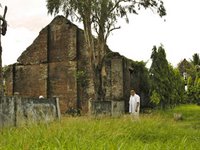 Our next stop was the town of Gattaran. But we weren’t going to the town church which was equally quaint. If only we weren’t pressed for time, I would have wanted to stop at the town church as well. Instead, we visited the Nassiping Church ruins which was the church of Nassiping town before it was merged with Gattaran.The stone side altars were quite intact. But a sad note was one of its bells was stolen last year, most probably by an antique dealer. I wish stealing these relics could be considered a heinous crime! These unscrupulous antique dealers should be shot by the towsfolk if they are caught carting away priceless pieces of heritage, to teach them a lesson. Check out the article in the PDI.Our next stop was the town of Lal-lo which was also known as Nueva Segovia. It was the former seat of the Diocese of Nueva Segovia before it was transferred to Vigan in 1758. The story of the transfer is in the Vigan website.
Our next stop was the town of Gattaran. But we weren’t going to the town church which was equally quaint. If only we weren’t pressed for time, I would have wanted to stop at the town church as well. Instead, we visited the Nassiping Church ruins which was the church of Nassiping town before it was merged with Gattaran.The stone side altars were quite intact. But a sad note was one of its bells was stolen last year, most probably by an antique dealer. I wish stealing these relics could be considered a heinous crime! These unscrupulous antique dealers should be shot by the towsfolk if they are caught carting away priceless pieces of heritage, to teach them a lesson. Check out the article in the PDI.Our next stop was the town of Lal-lo which was also known as Nueva Segovia. It was the former seat of the Diocese of Nueva Segovia before it was transferred to Vigan in 1758. The story of the transfer is in the Vigan website.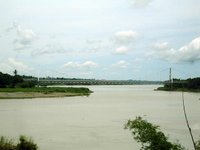 But before visiting the old church, we passed by the Magapit Suspension Bridge which spans the Cagayan River. It was one of the most modern in Asia during its time. Another monumental Marcos project which lessened the travel time between Cagayan and Ilocos, it shows us how much Philippine infrastructure has deteriorated today. The DPWH should let architects and not engineers design bridges. That's if they want to rid themselves of the reputation of churning out the ugliest infrastructure in the world! The only recently constructed bridge worth praising is the Bamban Bridge linking Mabalacat and Bamban. But then again, that was a Japanese financed project. Hehe!
But before visiting the old church, we passed by the Magapit Suspension Bridge which spans the Cagayan River. It was one of the most modern in Asia during its time. Another monumental Marcos project which lessened the travel time between Cagayan and Ilocos, it shows us how much Philippine infrastructure has deteriorated today. The DPWH should let architects and not engineers design bridges. That's if they want to rid themselves of the reputation of churning out the ugliest infrastructure in the world! The only recently constructed bridge worth praising is the Bamban Bridge linking Mabalacat and Bamban. But then again, that was a Japanese financed project. Hehe!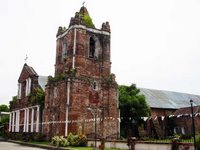 Anyway, the facade of the Lal-lo Church was similar to that of Alcala. In front of the church was an wooden cross encased in glass. According to the marker, it was planted there over 300 years ago by the Dominican missionaries who evangelized Cagayan.From Lal-lo, we moved on to the next town Camalaniugan which housed the oldest Catholic bell in the Far East. Before visiting the church, we passed by another horno. Unlike the one in Tuguegarao which was obviously neglected, this horno was well-cared for by the local community. In fact, there were even signages pointing to the place.
Anyway, the facade of the Lal-lo Church was similar to that of Alcala. In front of the church was an wooden cross encased in glass. According to the marker, it was planted there over 300 years ago by the Dominican missionaries who evangelized Cagayan.From Lal-lo, we moved on to the next town Camalaniugan which housed the oldest Catholic bell in the Far East. Before visiting the church, we passed by another horno. Unlike the one in Tuguegarao which was obviously neglected, this horno was well-cared for by the local community. In fact, there were even signages pointing to the place. When we got there, we were greeted by an horno which was close to 100 percent intact. Makeshift fences around plants in the area showed that this piece of heritage was very important to the local government and the townsfolk. Two thumbs up to them!Next stop was the church. But we received a shock since there was a totally new church being constructed right beside the old belfry. I learned from Jojo that the one it replaced wasn't old either and the original church was lost maybe in the 1970s.
When we got there, we were greeted by an horno which was close to 100 percent intact. Makeshift fences around plants in the area showed that this piece of heritage was very important to the local government and the townsfolk. Two thumbs up to them!Next stop was the church. But we received a shock since there was a totally new church being constructed right beside the old belfry. I learned from Jojo that the one it replaced wasn't old either and the original church was lost maybe in the 1970s. Anyway, we were disappointed when we saw the belfry since there was a big tarpaulin streamer covering the structure just like in Alcala. We were saying that the priest should have placed the streamer in front of the construction rather than on the belfry. I hope Fr. Camilo Castillejo removes his billboard from the belfry which is on the side of the oldest bell which dates back to 1595.That was the end of our morning itinerary and it was time to move back to Tuguegarao. Again, if we weren't pressed for time, I would have wanted to visit the next town which was Aparri and find out for myself what this town, made famous by the Eat Bulaga jingle, is all about. Hehe!We stopped by Alcala again to buy some milk candies made from carabao's milk. These flat candies are Alcala's version of the pastillas. Along the way, I think it was in Iguig, we also bought corn from vendors along the highway.
Anyway, we were disappointed when we saw the belfry since there was a big tarpaulin streamer covering the structure just like in Alcala. We were saying that the priest should have placed the streamer in front of the construction rather than on the belfry. I hope Fr. Camilo Castillejo removes his billboard from the belfry which is on the side of the oldest bell which dates back to 1595.That was the end of our morning itinerary and it was time to move back to Tuguegarao. Again, if we weren't pressed for time, I would have wanted to visit the next town which was Aparri and find out for myself what this town, made famous by the Eat Bulaga jingle, is all about. Hehe!We stopped by Alcala again to buy some milk candies made from carabao's milk. These flat candies are Alcala's version of the pastillas. Along the way, I think it was in Iguig, we also bought corn from vendors along the highway.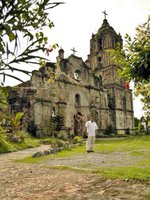 Back at the hotel, we packed our stuff and went down for a quick lunch before checking out. From there, it was a long drive to Isabela along the old highway to the town of San Pablo where ruins of an old church could be found. What is peculiar about this church is its size since it is unusually large for the community it currently serves.According to accounts, San Pablo was a very prosperous town before which explains the large church. But as the years passed, people left and fortunes changed. And the church as well as other structures were left to decay. Today, only half the church is in use, having been covered by a makeshift roof and walls. It would just be too costly to restore the church entirely. But from the intricate brick designs, one could imagine its past grandeur as a center of life in Isabela.
Back at the hotel, we packed our stuff and went down for a quick lunch before checking out. From there, it was a long drive to Isabela along the old highway to the town of San Pablo where ruins of an old church could be found. What is peculiar about this church is its size since it is unusually large for the community it currently serves.According to accounts, San Pablo was a very prosperous town before which explains the large church. But as the years passed, people left and fortunes changed. And the church as well as other structures were left to decay. Today, only half the church is in use, having been covered by a makeshift roof and walls. It would just be too costly to restore the church entirely. But from the intricate brick designs, one could imagine its past grandeur as a center of life in Isabela.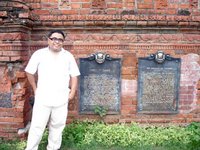 From there, we went further south to Tumauini to visit the Church of San Matias, a national cultural treasure. Just like the Callao Caves, this was another famous image in books. And finally, I got to see it for myself. I was not disappointed.The facade is said to be Pampanga's greatest contribution to Cagayan Valley heritage since it is said that Kapampangan woodcarvers were imported to create the moulds for the intricate and ornate brick tiles that adorned Tumauini and many other churches in the Cagayan Valley.
From there, we went further south to Tumauini to visit the Church of San Matias, a national cultural treasure. Just like the Callao Caves, this was another famous image in books. And finally, I got to see it for myself. I was not disappointed.The facade is said to be Pampanga's greatest contribution to Cagayan Valley heritage since it is said that Kapampangan woodcarvers were imported to create the moulds for the intricate and ornate brick tiles that adorned Tumauini and many other churches in the Cagayan Valley.
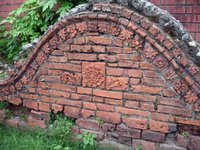 It's a pity Pampanga did not have an abundance of bricks because Tumauini was just breathtaking, each brick carefully planned and numbered to create this mosaic of ornate clay tiles.Even the walls that surrounded the church plaza was generously decorated with designed brick tiles! Indeed, Tumauini deserves its declaration as a national cultural treasure.
It's a pity Pampanga did not have an abundance of bricks because Tumauini was just breathtaking, each brick carefully planned and numbered to create this mosaic of ornate clay tiles.Even the walls that surrounded the church plaza was generously decorated with designed brick tiles! Indeed, Tumauini deserves its declaration as a national cultural treasure.
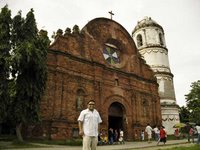 Another unique feature is the cylindrical belfry which is designed like a wedding cake. It's the only cylindrical belfry left in the country today, the other one in Leyte having been demolished by you know who. Sigh! I wonder why Tumauini, and many other deserving churches, weren't included in the original UNESCO declaration which sadly only includes Augustinian churches. Hope they make it to the expansion.
Another unique feature is the cylindrical belfry which is designed like a wedding cake. It's the only cylindrical belfry left in the country today, the other one in Leyte having been demolished by you know who. Sigh! I wonder why Tumauini, and many other deserving churches, weren't included in the original UNESCO declaration which sadly only includes Augustinian churches. Hope they make it to the expansion. Anyway, from there, it was off to Cauayan again for dinner at the Jambalaya Grill. But we stopped over in the provincial capital Ilagan to check out the biggest butaca or armchair which is on display along the national highway. After some fun shots on the giant wooden chair, we left for Cauayan.We were there at about 5:30 p.m. just in time for early dinner. After dinner, Jojo made a synthesis lecture of the learnings from the past two days. Then it was off to Manila at about 7:30 p.m. We made a number of stopovers to make sure the drivers were awake. And one of them was near Balete Pass where I bought some perantes, the citrus fruit of Nueva Vizcaya. Although the best place to buy them is along the highway somewhere near Bambang if I'm not mistaken. We arrived in U.P. at about 5 a.m. Lucky for the students, classes were suspended in anticipation of the heavy traffic due to today's SONA. So I'm sure everyone went straight to bed. Hehe!The rest of the photos are at http://photos.yahoo.com/ivanhenares and http://ivanhenares.multiply.com/photos as well as in Karlo de Leon's blog.
Anyway, from there, it was off to Cauayan again for dinner at the Jambalaya Grill. But we stopped over in the provincial capital Ilagan to check out the biggest butaca or armchair which is on display along the national highway. After some fun shots on the giant wooden chair, we left for Cauayan.We were there at about 5:30 p.m. just in time for early dinner. After dinner, Jojo made a synthesis lecture of the learnings from the past two days. Then it was off to Manila at about 7:30 p.m. We made a number of stopovers to make sure the drivers were awake. And one of them was near Balete Pass where I bought some perantes, the citrus fruit of Nueva Vizcaya. Although the best place to buy them is along the highway somewhere near Bambang if I'm not mistaken. We arrived in U.P. at about 5 a.m. Lucky for the students, classes were suspended in anticipation of the heavy traffic due to today's SONA. So I'm sure everyone went straight to bed. Hehe!The rest of the photos are at http://photos.yahoo.com/ivanhenares and http://ivanhenares.multiply.com/photos as well as in Karlo de Leon's blog.
 Finally, I've reached the last two provinces of northeastern Luzon Island! Yes, we visited Cagayan and Isabela today. Just like the Ilocos trip in July last year, I joined the Arch 17 class of Prof. Jojo Mata for the semestral study tour organized by the UP College of Architecture HTC Lab.We left UP at 10 p.m yesterday and arrived in Cauayan, Isabela at 6 a.m. just in time for breakfast at the Jambalaya Grill. After a hearty breakfast, we went to the Magat Dam in Ramon. Although I was surprised to see a sign along the road a few meters from the dam that we were in Alfonso Lista, Ifugao.
Finally, I've reached the last two provinces of northeastern Luzon Island! Yes, we visited Cagayan and Isabela today. Just like the Ilocos trip in July last year, I joined the Arch 17 class of Prof. Jojo Mata for the semestral study tour organized by the UP College of Architecture HTC Lab.We left UP at 10 p.m yesterday and arrived in Cauayan, Isabela at 6 a.m. just in time for breakfast at the Jambalaya Grill. After a hearty breakfast, we went to the Magat Dam in Ramon. Although I was surprised to see a sign along the road a few meters from the dam that we were in Alfonso Lista, Ifugao. It was a massive structure which reminded me of the Marcosian-era of the Philippines, the last time when the Philippine government thought big. If there was one thing I would hand to Ferdinand Marcos and his wife Imelda, they left their legacies in architectural monuments such as the Cultural Center of the Philippines and massive infrastructure projects such as the Magat Dam. No other president after them left monumental legacies not including of course Ramos' white elephant known as Expo Filipino.From the Magat Dam, we went straight to our hotel in Tuguegarao City
It was a massive structure which reminded me of the Marcosian-era of the Philippines, the last time when the Philippine government thought big. If there was one thing I would hand to Ferdinand Marcos and his wife Imelda, they left their legacies in architectural monuments such as the Cultural Center of the Philippines and massive infrastructure projects such as the Magat Dam. No other president after them left monumental legacies not including of course Ramos' white elephant known as Expo Filipino.From the Magat Dam, we went straight to our hotel in Tuguegarao City in
Cagayan to freshen up, get some rest and have lunch. After lunch, we went to the Tuguegarao Cathedral, a heritage horror which Jojo calls a "good example of a bad example!" Imagine, they demolished the old brick convento right beside the church and replaced it with this horrible commercial structure and multi-purpose hall which is still under construction at this moment. Now you see why we can't entrust heritage decisions to some bishops because they themselves are at times the culprits.That also happened in Lingayen, Pangasinan just recently. Instead of demolishing these centuries-old conventos and replacing them with horrible new buildings, the bishops could have contacted the NCCA or a conservation architect to consult them on how to do adaptive reuse of the conventos, meaning tranforming the interior of the conventos in order for them to serve the purpose intended for new buildings. In that manner, heritage is preserved and the bishops get the income they want.
Imagine, they demolished the old brick convento right beside the church and replaced it with this horrible commercial structure and multi-purpose hall which is still under construction at this moment. Now you see why we can't entrust heritage decisions to some bishops because they themselves are at times the culprits.That also happened in Lingayen, Pangasinan just recently. Instead of demolishing these centuries-old conventos and replacing them with horrible new buildings, the bishops could have contacted the NCCA or a conservation architect to consult them on how to do adaptive reuse of the conventos, meaning tranforming the interior of the conventos in order for them to serve the purpose intended for new buildings. In that manner, heritage is preserved and the bishops get the income they want.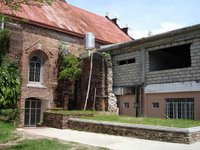 Yes, the bottomline was income for the bishops since commercial stalls replaced the old conventos when the said stalls could have been integrated properly with the old conventos had they consulted. Notice also the water tank on top of the demolished part of the convento. You can really see how some priests and bishops treat our national heritage.Tuguegarao is actually an urban planning disaster having transformed itself into another nondescript Philippine city without character. Not much of its heritage is left since Church and State seemed to have formed a perfect tandem in eradicating its rich past. Add to the fact that the roads are literally congested with tricycles. Yes people! After Cabanatuan, Tuguegarao follows with the most number of tricycle franchises issued. Driving in the city streets is a nightmare since the drivers treat the roads as if they were theirs.We then visited a horno, an oven for baking bricks, in some forgotten corner of the city. I guess the city government has no plans of caring for the site since it's already hidden in a rundown residential area right beside a basketball court which is obviously more important to the people than this relic of the past.
Yes, the bottomline was income for the bishops since commercial stalls replaced the old conventos when the said stalls could have been integrated properly with the old conventos had they consulted. Notice also the water tank on top of the demolished part of the convento. You can really see how some priests and bishops treat our national heritage.Tuguegarao is actually an urban planning disaster having transformed itself into another nondescript Philippine city without character. Not much of its heritage is left since Church and State seemed to have formed a perfect tandem in eradicating its rich past. Add to the fact that the roads are literally congested with tricycles. Yes people! After Cabanatuan, Tuguegarao follows with the most number of tricycle franchises issued. Driving in the city streets is a nightmare since the drivers treat the roads as if they were theirs.We then visited a horno, an oven for baking bricks, in some forgotten corner of the city. I guess the city government has no plans of caring for the site since it's already hidden in a rundown residential area right beside a basketball court which is obviously more important to the people than this relic of the past. But these depressing episodes would soon be forgotten as we crossed into the next town Peñablanca to visit the Peñablanca Protected Landscapes and Seascapes, in particular, the famous Callao Caves. The image of the caves is so popular owing to the little chapel inside a large cavern which receives sunlight from a natural opening above. Finally, I get to visit the famous caves. But the signature ray of sunlight wasn't there since it enters the cave only at a particular time of the day.Getting up to the caves can be exhausting thanks to the 183 steps you have to climb to get to the top! But you will be rewarded with surreal rock formations that are very easy to explore.
But these depressing episodes would soon be forgotten as we crossed into the next town Peñablanca to visit the Peñablanca Protected Landscapes and Seascapes, in particular, the famous Callao Caves. The image of the caves is so popular owing to the little chapel inside a large cavern which receives sunlight from a natural opening above. Finally, I get to visit the famous caves. But the signature ray of sunlight wasn't there since it enters the cave only at a particular time of the day.Getting up to the caves can be exhausting thanks to the 183 steps you have to climb to get to the top! But you will be rewarded with surreal rock formations that are very easy to explore.
 After the caves, we went down to the banks of the Pinacanauan River for a boat trip that offered us spectacular views of limestone cliffs covered with lush forests. Indeed, this was a reminder that the Philippines had a lot to offer and if we let all of this go by neglecting our natural heritage, it's the next generation of Filipinos that would suffer.I really hope illegal logging in this part of the country, particularly Cagayan and Isabela, is stopped. But we all know why it still goes on. If politicians in the area can't curb illegal logging, it's either they are weak and don't have the political will, or more plausible is that they are earning from it as well!
After the caves, we went down to the banks of the Pinacanauan River for a boat trip that offered us spectacular views of limestone cliffs covered with lush forests. Indeed, this was a reminder that the Philippines had a lot to offer and if we let all of this go by neglecting our natural heritage, it's the next generation of Filipinos that would suffer.I really hope illegal logging in this part of the country, particularly Cagayan and Isabela, is stopped. But we all know why it still goes on. If politicians in the area can't curb illegal logging, it's either they are weak and don't have the political will, or more plausible is that they are earning from it as well! We went back to Tuguegarao to get our long-needed rest and for dinner of course. The next day's itinerary was mostly church heritage. I'm quite excited since I rarely visit the Cagayan Valley owing to its distance from Manila. Last time I visited was in 2002 during a conference in Bayombong, Nueva Vizcaya. As part of the conference we visited the church in Dupax del Sur which is a national cultural treasure.It looks like I'm close to completing the provinces of Luzon Island soon. With my visits to Isabela and Cagayan today, that leaves seven namely Quirino, Kalinga, Apayao, Abra, Aurora, Camarines Norte, and Sorsogon; plus of course six island provinces of Luzon which are Batanes, Occidental Mindoro, Romblon, Marinduque, Masbate and Catanduanes which I hope to visit in the near future. Hehe!
We went back to Tuguegarao to get our long-needed rest and for dinner of course. The next day's itinerary was mostly church heritage. I'm quite excited since I rarely visit the Cagayan Valley owing to its distance from Manila. Last time I visited was in 2002 during a conference in Bayombong, Nueva Vizcaya. As part of the conference we visited the church in Dupax del Sur which is a national cultural treasure.It looks like I'm close to completing the provinces of Luzon Island soon. With my visits to Isabela and Cagayan today, that leaves seven namely Quirino, Kalinga, Apayao, Abra, Aurora, Camarines Norte, and Sorsogon; plus of course six island provinces of Luzon which are Batanes, Occidental Mindoro, Romblon, Marinduque, Masbate and Catanduanes which I hope to visit in the near future. Hehe!
 They call it a piece of Hawaii in the Philippines. But indeed, the Mount Malarayat Golf and Country Club in Lipa, Batangas offers some of the best views of Philippine landscape architecture at its finest. I was lucky to spend a relaxing day enjoying the serene views of a well-landscaped golf course amidst the backdrop of Mount Malarayat. Such a conducive place for a meeting that would otherwise have been quite exhausting if not for the great view from the function room.It turns out, the landscape architects were led by none other than National Artist for Architecture, Ildefonso P. Santos and Associates as well as Pesons, Dimanlig, Aleta, Alcazaren (PDAA) Partners whom I believe are professors of landscape architecture at the University of the Philippines.I hope we get more of the Philippines landscaped by professionals!
They call it a piece of Hawaii in the Philippines. But indeed, the Mount Malarayat Golf and Country Club in Lipa, Batangas offers some of the best views of Philippine landscape architecture at its finest. I was lucky to spend a relaxing day enjoying the serene views of a well-landscaped golf course amidst the backdrop of Mount Malarayat. Such a conducive place for a meeting that would otherwise have been quite exhausting if not for the great view from the function room.It turns out, the landscape architects were led by none other than National Artist for Architecture, Ildefonso P. Santos and Associates as well as Pesons, Dimanlig, Aleta, Alcazaren (PDAA) Partners whom I believe are professors of landscape architecture at the University of the Philippines.I hope we get more of the Philippines landscaped by professionals!
 We have been trying influence many of the local government leaders and the clergy to adopt heritage conservation practices to preserve the character of our own cities and towns. But add to the fact that so much was already lost during the Second World War which is why we have to be more aggressive in protecting what's left.
We have been trying influence many of the local government leaders and the clergy to adopt heritage conservation practices to preserve the character of our own cities and towns. But add to the fact that so much was already lost during the Second World War which is why we have to be more aggressive in protecting what's left.





















